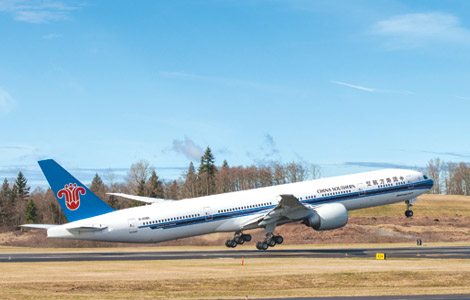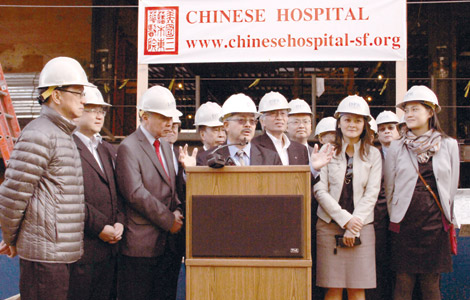US firms in China look to services, survey shows
Updated: 2014-02-26 02:20
By HE WEI in Shanghai (China Daily)
|
||||||||
US companies in China are shifting their focus to the service sector in line with China's transition from being the world's factory floor to a knowledge-driven economy, a survey has found.
For the first time, services accounted for more than half, or 52 percent, of US companies' revenue in China in 2013, up 11 percentage points from the previous year.
This is according to the annual China Business Report released on Tuesday by the American Chamber of Commerce in Shanghai.
The survey, which tracks performance and confidence of the largest US business community in China, shows that companies are continuing to move beyond purely manufacturing for exports as costs surge and markets mature.
The growing importance of services contrasts sharply with manufacturing, which dropped by 10 percent to comprise 37 percent of companies' revenues in 2013, the survey shows.
"It is important to keep in mind that China's leadership has prioritized the development of the country's service sectors, and American businesses are world leaders in these areas," said Kenneth Jarrett, president of AmCham Shanghai.
Tim Huang, chief operating officer of Bank of America Merrill Lynch in Shanghai, said, "I've seen a growing number of our clients in the service sector in the past five years and I expect this trend to continue."
The study interviewed 399 member companies that run operations in first-tier cities including Shanghai and Beijing, the Yangtze River Delta region, as well as central and western powerhouses of China. Fifty-four percent of them have been in the country for more than 10 years.
The service sector accounted for 46.1 percent of China's gross domestic product in 2013, outpacing manufacturing for the first time in the country's economic output, according to the National Bureau of Statistics. Shanghai has the largest proportion of the service sector, with more than 62.6 percent.
Buoyancy in the sector is backed by the increasing presence of small and medium-sized US enterprises, thanks to growing transparency in China and lingering economic struggles in the home market, the survey found.
Thirty-seven percent of companies identified themselves as small and medium-sized enterprises in 2013, or firms with 500 or fewer employees worldwide, up from about 25 percent a year ago.
The first wave of SMEs to settle in China arrived in early 2000, largely to adjust to demands by multinational corporations that invested in the country earlier, said Chris Wingo, founder of China Sage Consultants (Shanghai) Co. His firm helped SMEs from the United States to prepare and manage their businesses in China.
But as more SMEs became interested in China's growth, and the US economy remained lackluster, China has been on the radar for many smaller US firms since the late 2000s,Wingo added.
Robert Theleen, who chairs AmCham Shanghai and is chief executive officer of merchant bank China-Vest, which is based in the city, said that with China demonstrating its ongoing commitment to economic liberalization through initiatives like the Shanghai Free Trade Zone, it is only natural that more firms are setting up in the country.
"When you combine this improving infrastructure with the decades of experience that American businesses now have in this market, it's easier for US companies to profit from China's growth, regardless of their size," he said.
China has continued to act as a key profit center for US companies, with 74 percent of respondents reporting profits in 2013. Three out of four saw positive cash flows in their China operations, up by 3 percentage points from a year ago.
Eighty-six percent of the firms surveyed said they remain "optimistic or slightly optimistic" about forecasts for China's business prospects in the next five years.
But only 65 percent of the firms reported making additional investment in China, down from 74 percent the previous year.
In addition, as a top-three investment priority China fell by 8 percentage points among respondents to 46 percent.
Kent Kedl, managing director for China and North Asia at Control Risks, a business consultancy, said this suggests a healthy rebound in developed economies, meaning that China is no longer the only "bright spot".
This trend is reflected in companies' efforts to integrate China further into their global operations.
Forty-three percent of firms said they conduct their research and development for China-specific products in both the US and China, with only 7 percent relying on US headquarters as their R&D hubs for designing products for the Chinese market.
The firms surveyed cited rising costs, constraints on human resources, and intensifying competition as the top three challenges hindering business performance in 2013.
For the third consecutive year, surging costs ranked the top business hurdle, with 89 percent of companies reporting increases in primary costs from labor to tax and materials.
Last year, companies also became increasingly concerned about complying with China's laws and regulations following efforts by the central government to target firms for corruption investigations.
- Shanghai district pushing financial services
- Nepal, China sign new air service agreement
- Taicang offers free legal services to seniors
- Urumqi Toutunhe district opens its first social work service center
- Foreign expert affairs head with educational services executive
- TEDA drawing tech firms with diverse services
Most Viewed
Editor's Picks

|

|

|

|

|

|
Today's Top News
US space telescope spots 715 more planets
Bags banned in Boston Marathon
Asiana fined $500,000 over SF crash
TPP talks in final stretch
LA rolls out the red carpet
Spotlight on Chinese publishing
Weibo faces modest growth in '14
Services top US firms' revenue
US Weekly

|

|














